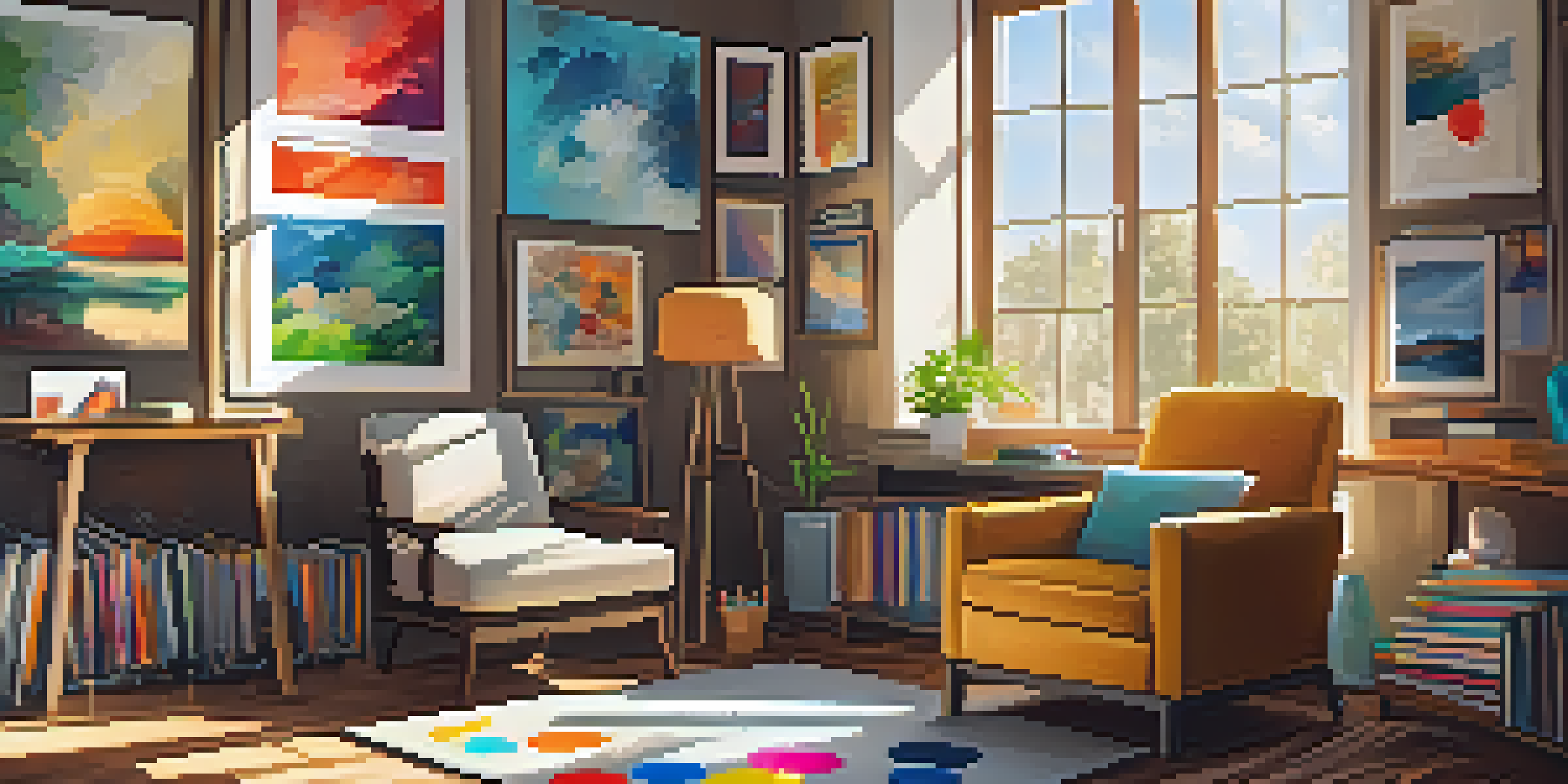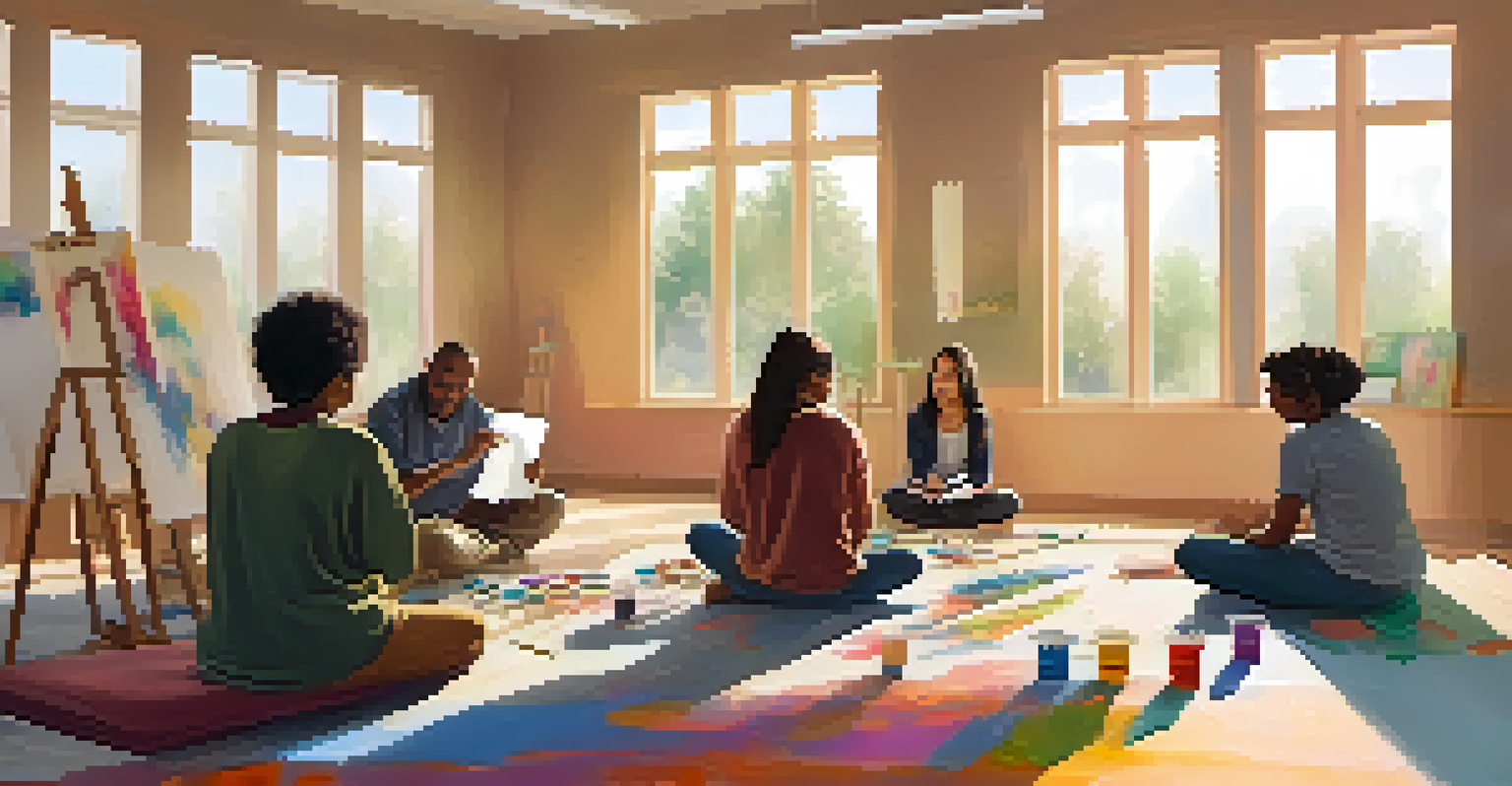Art Therapy as a Tool for Managing Seasonal Affective Disorder

Understanding Seasonal Affective Disorder (SAD)
Seasonal Affective Disorder, commonly known as SAD, is a type of depression that occurs at certain times of the year, often in the fall and winter months. This condition is primarily linked to changes in daylight, which can disrupt our natural rhythms and mood. Many people experience symptoms like fatigue, social withdrawal, and a general sense of sadness during this period.
Art enables us to find ourselves and lose ourselves at the same time.
Research suggests that the lack of sunlight can affect serotonin levels, a neurotransmitter that plays a crucial role in regulating mood. As the days grow shorter, individuals with SAD may feel increasingly isolated and downcast. It's important to recognize that these feelings are not just a phase; they can significantly impact daily life.
Fortunately, there are various treatments available to help manage SAD, including light therapy, medication, and psychotherapy. Among these, art therapy has emerged as an effective, creative approach that can be especially beneficial. Engaging in artistic expression may help individuals process their emotions and combat the feelings of sadness associated with SAD.
What is Art Therapy?
Art therapy combines psychology and artistic expression, providing a unique way for individuals to communicate their feelings and thoughts. Unlike traditional talk therapy, art therapy allows for expression through various mediums such as painting, drawing, and sculpture. This can be particularly helpful for those who struggle to articulate their emotions verbally.

The process of creating art can be therapeutic in itself, offering a sense of accomplishment and joy. As individuals immerse themselves in the creative process, they often find a release from stress and anxiety. Through art, people can explore their inner thoughts and feelings in a non-threatening environment, making it easier to confront difficult emotions.
SAD Affects Mood in Winter
Seasonal Affective Disorder (SAD) is a type of depression linked to reduced daylight during fall and winter, leading to feelings of fatigue and isolation.
Art therapists are trained professionals who guide individuals through this creative journey. They provide support and insight while helping clients to interpret their artwork, unveiling deeper insights about their emotional state. This therapeutic relationship can foster a sense of safety and trust, allowing individuals to delve into their feelings about SAD.
The Benefits of Art Therapy for SAD
Art therapy offers numerous benefits for those grappling with Seasonal Affective Disorder. One significant advantage is its ability to promote emotional expression, allowing individuals to articulate feelings that may be difficult to verbalize. By creating art, individuals can release pent-up emotions and gain clarity about their experiences.
Every artist was first an amateur.
Moreover, engaging in art can serve as a form of mindfulness, pulling individuals into the present moment and away from negative thoughts. This focus can help reduce anxiety and promote a sense of calm, which is particularly beneficial during the darker months. As creativity flows, many find a sense of relief from the heavy weight of SAD.
Additionally, art therapy fosters social connection, which is vital for combating feelings of isolation. Group art therapy sessions provide a space for individuals to share their experiences and support one another, reducing the loneliness often associated with SAD. This sense of community can be incredibly uplifting and healing.
How to Engage in Art Therapy
Getting started with art therapy doesn't require any artistic skills or experience. The beauty of art therapy lies in the process, not the outcome. Individuals can engage in simple activities like doodling, painting, or even coloring in adult coloring books to begin expressing themselves creatively.
Many people find it helpful to set aside dedicated time for art activities, especially during the winter months when SAD symptoms may be more pronounced. Creating a cozy, inspiring space can also enhance the experience, making it more inviting to explore one's creativity. Soft music, natural light, or even candlelight can help set the mood for artistic expression.
Art Therapy as a Creative Outlet
Art therapy provides a unique way for individuals to express emotions creatively, helping to alleviate symptoms of SAD.
For those interested in a more structured approach, seeking out a licensed art therapist can provide additional support. These professionals can tailor sessions to meet individual needs, guiding clients through specific techniques and themes that resonate with their emotional state. Whether in a group setting or one-on-one, working with an art therapist can amplify the benefits of creative expression.
Incorporating Daily Art Practices
Incorporating art into daily life can be a powerful tool for managing SAD symptoms. Simple practices, such as journaling with sketches, creating a vision board, or engaging in daily doodling, can serve as regular outlets for emotional expression. This daily commitment to creativity helps build resilience against the low moods associated with SAD.
For those who may feel overwhelmed by larger projects, starting small is key. Setting a timer for just 10-15 minutes of creative activity can make it feel manageable and less daunting. Over time, these small bursts of creativity can accumulate, providing a significant emotional release and sense of accomplishment.
Additionally, sharing artwork with friends or family can help foster connections and open up conversations about feelings. This not only provides a chance for support but also encourages others to engage in their own creative practices. Remember, the goal is not perfection but rather self-exploration and emotional release.
Finding Support for Art Therapy
If you're considering art therapy to manage SAD, finding the right support is crucial. Many mental health professionals specialize in art therapy and can provide guidance tailored to your specific needs. Online directories and local mental health organizations can help you connect with qualified art therapists in your area.
Additionally, community centers and wellness organizations often offer art therapy workshops or groups. Participating in these sessions can provide a supportive environment where you can connect with others facing similar challenges. This sense of community can be incredibly beneficial for those dealing with the isolating effects of SAD.
Daily Art Practices Build Resilience
Incorporating simple art activities into daily routines can serve as effective tools for managing SAD symptoms and fostering emotional expression.
It's also worth exploring online resources, such as virtual art therapy sessions or guided workshops. These options can be especially appealing for individuals who may not have access to local services or prefer the comfort of their own home. Regardless of the format, seeking support is a vital step toward managing Seasonal Affective Disorder.
Conclusion: Embracing Art as a Healing Tool
Art therapy stands out as a valuable tool for managing Seasonal Affective Disorder, offering a creative pathway to emotional expression and healing. By engaging in artistic activities, individuals can explore their feelings, reduce anxiety, and foster social connections. This holistic approach not only addresses the symptoms of SAD but also nurtures the soul.
As the seasons change and the days grow shorter, embracing art can provide a light in the darkness. Whether through structured therapy or personal creative practices, the act of making art can infuse joy and clarity into challenging times. Remember, you don’t have to be a professional artist to benefit; the act of creating is what matters.

Incorporating art into your self-care routine can be a transformative experience. So grab those paints, pencils, or clay, and let your creativity flow. You may just find that art is the perfect antidote to the winter blues.